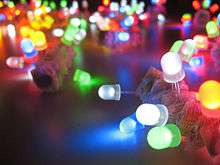Graffiti Research Lab
Graffiti Research Lab, founded by Evan Roth and James Powderly during their fellowships at the Eyebeam OpenLab, is an art group dedicated to outfitting graffiti writers, artists and protesters with open source technologies for urban communication. The members of the group experiment in a lab and in the field to develop and test a range of experimental technologies. They document those efforts with video documentation and DIY instructions for each project and make it available for everybody. The GRL is particularly well known for inventing LED Throwies.
Graffiti Research Lab | |
|---|---|
| Born | |
| Nationality | American |
| Known for | Video, performance, new media art, street art, graffiti |
Notable work | Laser tag, LED Throwies |
The Graffiti Research Lab is currently housed at Free Art and Technology Lab (a.k.a. FAT Lab), a non-profit research lab that supports artists, engineers, designers and entertainers whose work directly enriches the public domain. (FATLAB website)
Each extension of Graffiti Research Lab is called a cell. Localized cells were founded in Vienna,[1] Amsterdam,[2] and Mexico,[3] copying and extending the work of the NY based organization. For example, the inventions are reproduced and deployed locally and the exhibition of the MBU at Prix Ars Electronica was done in cooperation with GRL Vienna. The cells cooperate and communicate, but are not one formal organization.
Inventions



- LED Throwies
- L.A.S.E.R. Tag, a computer vision system paired with a projector that enables one to write on walls using a high-power laser pointer.
- Electrograf, a technique for building circuits on any surface using electrically conductive paint and/or tape
- High Writer, an extension pole for tagging hard-to-reach locations, based on an initial design by Barry McGee.
- Night Writer, for putting LED throwies in hard-to-reach locations by mounting them on a grid to write text.
- Graffiti POV CAM
- Homeland Security Advisory System, installed at 11 Spring Street in Soho, NYC
Projects
Projects include: Powerthief, 24C3, Berlin, Lazah Pong, Make Magazine's Laser Marker How-To, and Urban Hacking, among others.[4]
Members
- Founders
- Collaborators
- Bennett Williamson
- Theo Watson (G.R.L. Amsterdam)
- Steve Lambert
- Jamie Wilkinson
- Mike Baca
- Todd Polenberg
- Michael Zeltner & Florian Hufsky (G.R.L. Vienna)
- KATSU (Artist, Vandal and Hacker)[5]
Exhibitions
- Prix Ars Electronica, Linz, Austria, (Official Website 2006), (Official Website 2007)
- NUART, Stavanger, Norway, (Official Website 2006)
- SIGGRAPH, Boston, USA, (Official Website 2006)
- Maker Faire, SF Bay Area, USA,(Official Website 2006)
- Transitio, Mexico City, Mexico, 2007, (Official Website)
- Art Rotterdam, Rotterdam, Netherlands, 2007, (Official Website)
- OFFF, Barcelona, Spain, (Official Website 2007)
- Open City, Eyebeam Art and Technology Center, NYC, 2007, (Official Website)
- Sundance Film Festival, Park City, USA, 2008(Official Website)
- Museum of Modern Art, New York City, USA, 2008 (Official Website)
References
- "GRL Vienna". Archived from the original on 2008-04-10. Retrieved 2008-02-24.
- "GRL Amsterdam". Archived from the original on 2008-04-22. Retrieved 2008-02-24.
- GRL Mexico
- "Archived copy". Archived from the original on 2008-12-05. Retrieved 2010-05-05.CS1 maint: archived copy as title (link)
- "Canadian Bacon (w/ Katsu)". Graffiti Research Lab. Retrieved 12 December 2012.
External links
- Graffiti Research Lab
- Eyebeam
- Artkrush.com feature on Graffiti Research Lab, January 2007
- Article: Geek Graffiti Takes on New York
- Article: The Writing's On the Wall (The Writing's Off the Wall) (New York Times)
- Article: Graffiti Goes LED (Wired)
- Article: Food for the Eyes and Ears (TIME)
- Article: Graffiti by the (Extensively Analyzed) Numbers (New York Times)
- L.A.S.E.R. Tag video of interventions. 2007–08